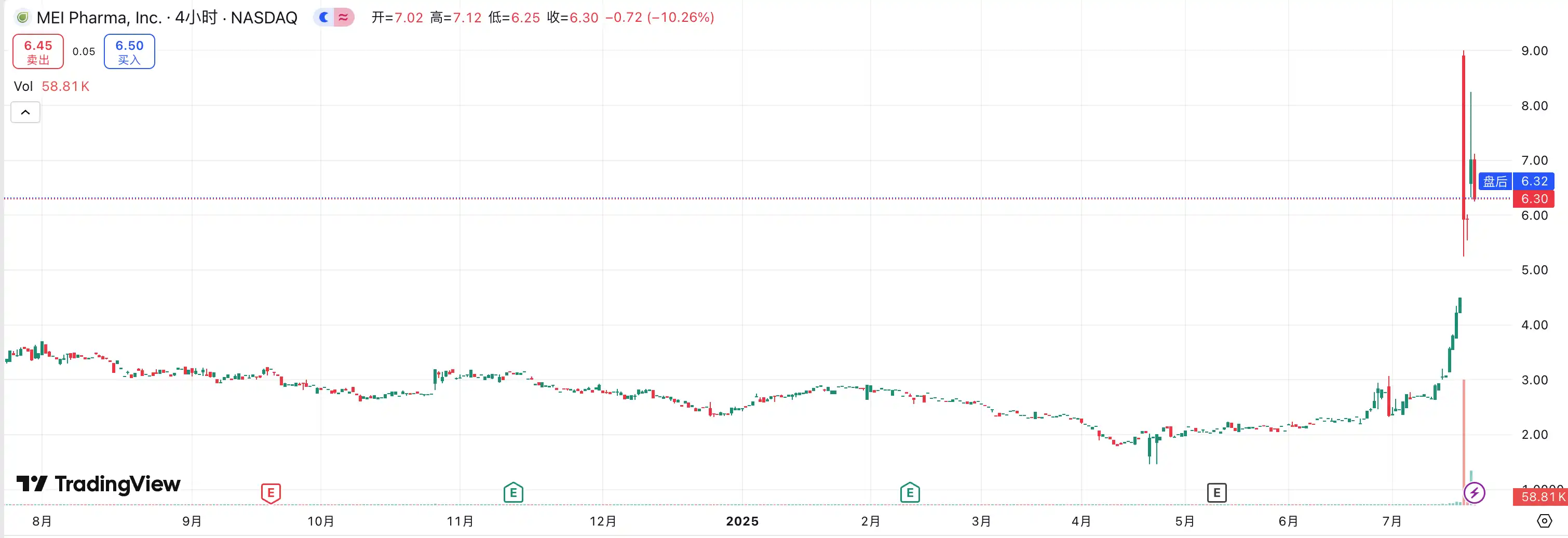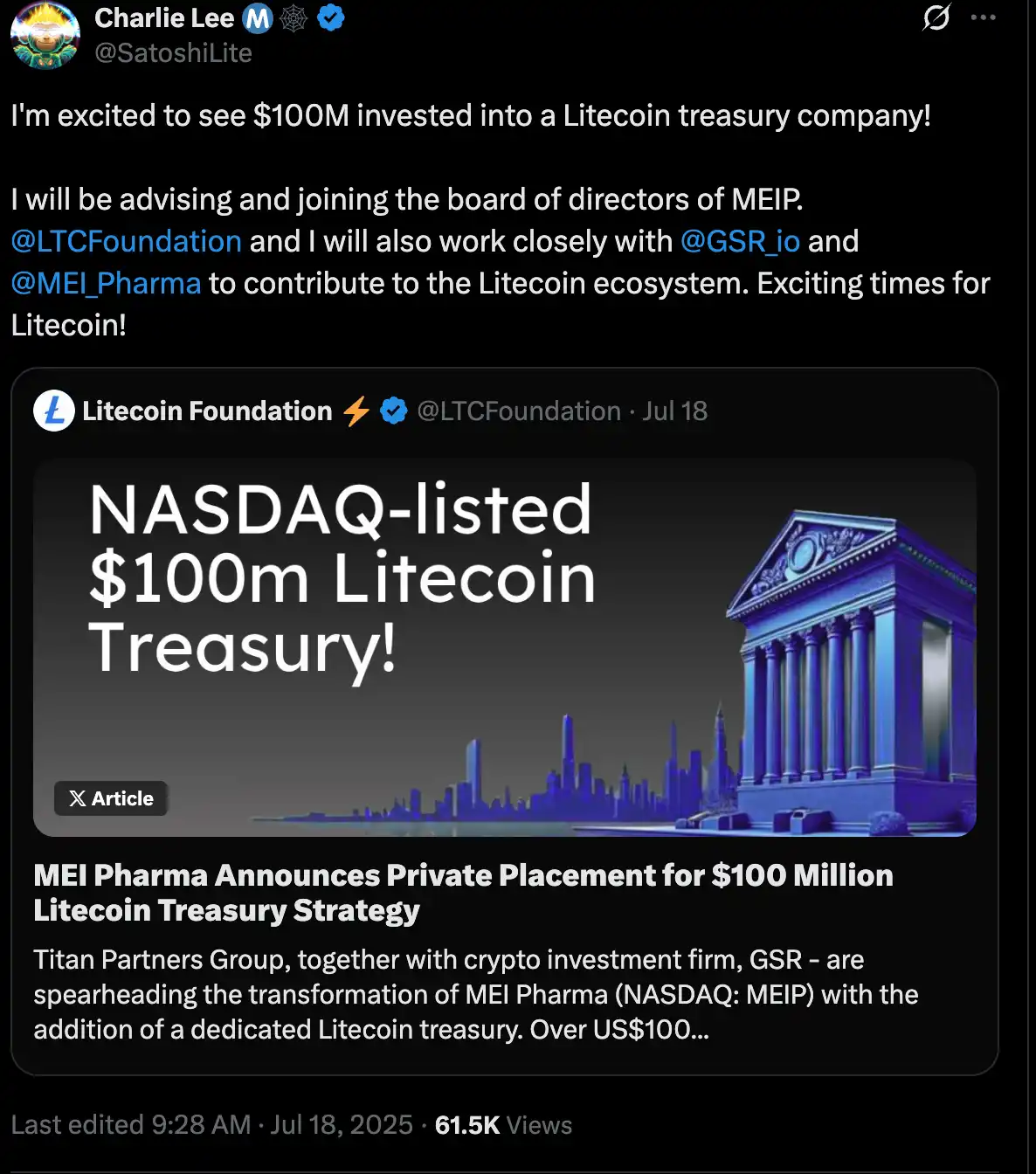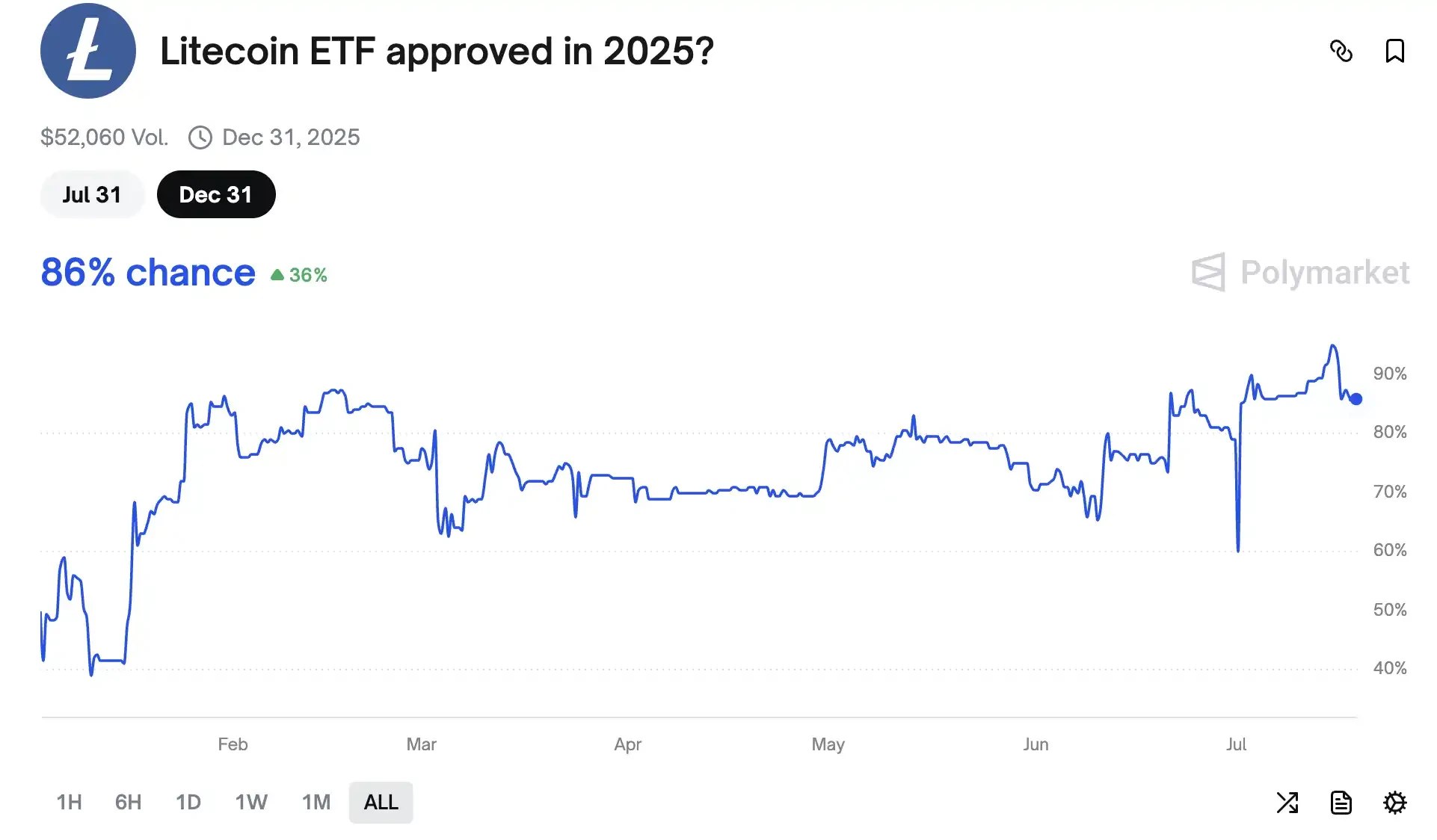MEI Pharma bets 100 million yuan on Litecoin, is the altcoin micro-strategy craze coming?
On July 19, US pharmaceutical company MEI Pharma (stock code: MEIP) announced a strategic transformation to promote its strategy of establishing a dedicated Litecoin treasury. Currently, more than $100 million in funds have been committed to the project.
As part of the transaction, the biotech company will appoint Litecoin founder Charlie Lee to its board of directors. GSR will also receive a board seat and serve in an important position on the companys digital asset and fund management advisory committee. In addition, the Litecoin Foundation has also invested in MEI Pharma because the companys treasury strategy is highly aligned with the Litecoin Foundations core mission to promote global Litecoin adoption.
After the announcement, MEIPs stock price soared 83.37% in pre-market trading on Friday, continuing the 16.58% increase of the previous day. The high point once reached $9 and is currently stable at $6.30. The trading volume on that day exceeded 13 million shares, far exceeding the daily average of 26,000 shares in the past three months. This change not only reflects the markets positive expectations for the companys blockchain transformation, but also marks that after mainstream تشفير assets such as ETH, SOL, and BNB, another altcoin micro-strategy model has officially started, and Litecoin (LTC) has ushered in a new chapter of institutional allocation.

MEI Pharma Completes Strategic Transformation: The First Listed Company to Establish Litecoin Strategic Reserve
MEI Pharma, Inc. is a biopharmaceutical company focused on the research and development of small molecule drug compounds. Its core RD projects include Voruciclib, a CDK inhibitor for the treatment of B-cell malignancies, and ME-344, a mitochondrial-targeted anticancer drug. The company was founded on December 1, 2000 and is headquartered in San Diego, California, USA.
On July 19, 2025, MEI Pharma announced that it would align with blockchain finance, launch a new round of private equity investment (PIPE) transactions, and plan to include Litecoin (LTC) in its company asset allocation, becoming the first listed biotech company to use LTC as its main financial reserve asset.
According to the announcement, this round of financing was jointly led by Titan Partners Group and cryptocurrency trading company GSR, which plans to issue 29,239,767 common shares or equivalent prepaid warrants at a price of US$3.42 per share, with a total financing scale of approximately US$100 million. The transaction is expected to be completed around July 22, 2025, subject to customary regulatory and delivery conditions.
Behind this financing, it is not only a capital operation, but also indicates that MEI is undergoing a deep strategic transformation. The company said that it had systematically evaluated the sustainability of the traditional biotechnology business model and decided to embrace the blockchain and decentralized finance (DeFi) field. It plans to reorganize its company treasury with Litecoin as the core asset and start long-term cooperation with the Litecoin Foundation and GSR.
Charlie Lee said in response to the cooperation: Litecoin has always adhered to the concept of fast, secure and decentralized since its inception in 2011. It is gratifying to see that a listed company like MEI can accept these principles. This not only reflects the growing confidence of institutions in LTC, but also lays the foundation for its further expansion in the traditional capital market.

Why choose Litecoin
Litecoin is one of the earliest altcoins to enter the market. It was created by former Google engineer Charlie Lee in 2011. Its core architecture is based on the open source code of Bitcoin, and a number of optimizations and upgrades have been made on this basis. Compared with Bitcoin, Litecoin blocks are generated faster and use the Scrypt Proof of Work (PoW) algorithm, which is more suitable for ordinary hardware mining and reduces the threshold for participation. Its total supply is set at 84 million pieces, and it has similar deflationary properties to Bitcoin – every 840,000 blocks will trigger a block reward halving mechanism.
As a representative of the first generation of altcoins, Litecoin has always been committed to improving the efficiency and scalability of on-chain transactions, and has the advantages of low fees and fast processing speed. In recent years, Litecoin has also gradually expanded its payment usage scenarios, including travel companies, convenience stores, real estate agencies, and online e-commerce. In 2021, the Litecoin Foundation announced that it would cooperate with financial service providers to issue Visa debit cards, allowing users to convert LTC into US dollars in real time to complete consumer payments, further consolidating its practical value.
Since the creation of Litecoin in 2011, Charlie Lee has been the core driving force behind this ecosystem. He not only advocates technological innovation, but also leads several key upgrade processes, including Litecoins selective integration of privacy features and activation of segregated witness. Charlie Lee has also invested in promoting lightning network experiments, mining pool collaboration, and developer community building, laying a solid foundation for the long-term development of the Bitcoin and Litecoin networks.
Today, his deep involvement in the MEI Pharma Litecoin Treasury has once again boosted the markets confidence in the Litecoin Treasury strategy. As the Litecoin Foundation emphasized in the announcement: For 14 years, Litecoin has consistently provided a stable, low-cost and easily accessible network to millions of users. This MEI cooperation not only means that Litecoin has been included in the financial structure of a US listed company for the first time, but also a strategically significant institutional-level financial experiment carried out with the direct participation of the founder.
At the same time, market expectations for Litecoin are rapidly rising. According to data from the decentralized prediction platform Polymarket, by the end of 2025, the probability of the U.S. Securities and تبادل Commission (SEC) approving a Litecoin spot ETF is as high as 86%. This not only reflects investors optimistic expectations for Litecoins regulatory prospects, but also reflects its trend of gradually entering the ranks of mainstream assets in the wave of compliance.
Once the spot ETF is approved, Litecoin will join Bitcoin and Ethereum as the core target of traditional financial investment portfolios, providing a legal and compliant allocation path for institutional funds. This will enhance LTCs market liquidity and valuation anchoring power, while further strengthening its market positioning as a payment-type digital asset and becoming a bridge connecting the on-chain world and Wall Street funds.

لخص
With MEI Pharma becoming the first listed company to include LTC in its financial reserves, following the launch of the micro-strategy mode for mainstream tokens such as Ethereum, BNB, and SOL, Litecoin has also officially joined this institutional position-increasing camp, announcing the launch of another vault path for altcoins. On the day the news was announced, Litecoin broke through the downward channel with a strong force, rising by more than 6% in 24 hours, with the price rising to $106 at one point, and then continued to rise to $115. This not only marks a revaluation of LTCs asset attributes, but also further strengthens the role of altcoin micro-strategy as a funding driver for this round of bull market. With the superposition of ETF concepts and the acceleration of institutional position building, the altcoin season is quietly opening.

This article is sourced from the internet: MEI Pharma bets 100 million yuan on Litecoin, is the altcoin micro-strategy craze coming?
Related: Capital bets on the prediction market, who is better, Polymarket or Kalshi?
Recently, Kalshi announced the completion of a US$185 million Series C financing led by Paradigm, with its valuation jumping to US$2 billion; at the same time, Polymarket is also preparing to complete a round of financing of nearly US$200 million, with a valuation exceeding US$1 billion. The frequent news of financing in the prediction platform track inevitably reminds people of the undercurrent of competition and tension between platforms. A showdown over the pricing power of future information is quietly unfolding. The love-hate relationship of prediction markets Kalshi was founded in 2020 and is headquartered in New York. It is currently the only legal prediction market platform approved by the U.S. Commodity Futures Trading Commission (CFTC). Its investors include Y Combinator, former Charles Schwab CEO David Pottruck, and crypto venture capital…





